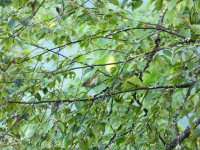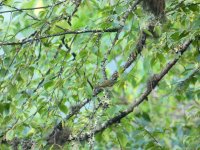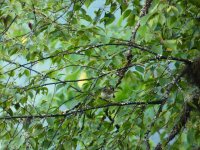Not my images but taken by an acquaintance who posted them on a Facebook friend. They were taken on 28 July at about 2600 m. The images are not great and need cropping but it's an interesting-looking Leaf Warbler with a very heavy and broad lateral crown-stripe and a bold whitish crown-stripe. The broad main wingbar, dark primary bases and centres to greater coverts visible in one shot and that badger-striped head lead me to the proregulus group. I was thinking Sichuan Leaf Warbler, Phylloscopus forresti, which definitely occurs here, but one of the images has a suggestion of a pale rump, making me wonder if we should also consider Chinese Leaf (yunnanensis). Emei also occurs here but I ruled it out - I hope I was right to do so! Any suggestions welcome. Grahame, John Allcock, Rockfowl - if you're around.....
-
Welcome to BirdForum, the internet's largest birding community with thousands of members from all over the world. The forums are dedicated to wild birds, birding, binoculars and equipment and all that goes with it.
Please register for an account to take part in the discussions in the forum, post your pictures in the gallery and more.
You are using an out of date browser. It may not display this or other websites correctly.
You should upgrade or use an alternative browser.
You should upgrade or use an alternative browser.
Leaf Warbler, Labahe, Erlangshan, Sichuan, China (1 Viewer)
- Thread starter andyb39
- Start date
More options
Who Replied?BobbitWorm45
Well-known member
From whay I understand the crown stripe on Chinese LW is somewhat dark olive particularly to the rear. Your bird seems to have bright crown stripe that would better fit Sichuan LW.
Grahame Walbridge
Well-known member
Surely either Claudia's LW or Kloss's LW (ssp disturbans at this location) with that head pattern Andy, the rather obvious pale nape patch and apparent absence of yellow tones suggest the former but I would leave at that at given the poor quality of the images.
Grahame.
Grahame.
Surely either Claudia's LW or Kloss's LW (ssp disturbans at this location) with that head pattern Andy, the rather obvious pale nape patch and apparent absence of yellow tones suggest the former but I would leave at that at given the poor quality of the images.
Grahame.
Hmm, very interesting. I had rejected Claudia's (which definitely does occur) because of the small, apparently darkish bill, the vivid coronal and the fact that the gc wingbar is distinctly broader than the mc one. As far as I know, Claudia's has a Blyth's-like bill with yellow lower mandible, which I'm not seeing here. The best image (6857183), however, shows that the crown-stripe is weaker at the front than the rear. I also have to admit that the same image doesn't show the shadow at the base of the primaries or dark centres to the greater coverts I thought I could see in another image.
Grahame Walbridge
Well-known member
Hmm, very interesting. I had rejected Claudia's (which definitely does occur) because of the small, apparently darkish bill, the vivid coronal and the fact that the gc wingbar is distinctly broader than the mc one. As far as I know, Claudia's has a Blyth's-like bill with yellow lower mandible, which I'm not seeing here. The best image (6857183), however, shows that the crown-stripe is weaker at the front than the rear. I also have to admit that the same image doesn't show the shadow at the base of the primaries or dark centres to the greater coverts I thought I could see in another image.
Andy you cannot possibly see the bill colour/pattern in these small images, in the 1st image you are just seeing the culmen and in the 3rd it's head-on. And yes, quite aside from the lack of dark-centred gc's and dark primary bases, the tertials are plain and the eye-stripe lacks a terminal 'hook'.
Grahame
Last edited:
Yes, right you are about the tertials - forgot about them. I sometimes feel I'm taking one step forwards and two steps back with these Leaf Warblers. I have one other image taken by the same observer at a different location - Huangshan, Anhui province. I thought this was Claudia's - both this species and Hartert's occur at this location. Fortunately, it being eastern China, none of the other little devils are present. Can you confirm?
Attachments
johnallcock
Well-known member
Surely either Claudia's LW or Kloss's LW (ssp disturbans at this location) with that head pattern Andy, the rather obvious pale nape patch and apparent absence of yellow tones suggest the former but I would leave at that at given the poor quality of the images.
Grahame.
Andy you cannot possibly see the bill colour/pattern in these small images, in the 1st image you are just seeing the culmen and in the 3rd it's head-on. And yes, quite aside from the lack of dark-centred gc's and dark primary bases, the tertials are plain and the eye-stripe lacks a terminal 'hook'.
Grahame
I agree with Grahame's assessment here. I'd also comment that I think you would see the pale rump clearly on the second image if it were Chinese or Sichuan Leaf.
Emei needs to be considered, because it's very similar to Claudia's. I think on this bird that the sides to the crown are too dark and the central crown stripe a bit too strong.
Yes, right you are about the tertials - forgot about them. I sometimes feel I'm taking one step forwards and two steps back with these Leaf Warblers. I have one other image taken by the same observer at a different location - Huangshan, Anhui province. I thought this was Claudia's - both this species and Hartert's occur at this location. Fortunately, it being eastern China, none of the other little devils are present. Can you confirm?
It does appear to be one of the Blyth's complex, and it looks like it's doing the usual wing flicking. The features for separation of Claudia's from fokiensis Hartert's on the basis of plumage are still not really known, so I'm not sure you can say it's one or the other on the basis of plumage.
Is Claudia's regular at this site? It seems a long way southeast of the usual range (mostly Sichuan, Shaanxi, Shanxi), which would perhaps favour Hartert's. The range limits of both species in China are still unclear because of the difficulty of ID and incomplete coverage of many areas. If both are present, they are probably separated altitudinally (this seems to be the case elsewhere).
There's a lot still to be learned about the Blyth's complex in China, so for now it's often best to accept that many records can't be confirmed to species level.
Is Claudia's regular at this site? It seems a long way southeast of the usual range (mostly Sichuan, Shaanxi, Shanxi), which would perhaps favour Hartert's. The range limits of both species in China are still unclear because of the difficulty of ID and incomplete coverage of many areas. If both are present, they are probably separated altitudinally (this seems to be the case elsewhere).
It's on the eBird checklist, and going through the checklists, one observer claimed two on 19 May 2018. However, a Per Smith claimed 4 Hartert's but no Claudia's on 13 May this year. There's a record of 5 Claudia's in April 2017, and a record of 1 from July 2014. Some observers reported Pallas's - I don't know if that's feasible. So it could be that people are mixing up their warblers - it wouldn't surprise me!
I'll ask the observer about the elevation where he took the shot.
It's on the eBird checklist, and going through the checklists, one observer claimed two on 19 May 2018. However, a Per Smith claimed 4 Hartert's but no Claudia's on 13 May this year. There's a record of 5 Claudia's in April 2017, and a record of 1 from July 2014. Some observers reported Pallas's - I don't know if that's feasible. So it could be that people are mixing up their warblers - it wouldn't surprise me!
I'll ask the observer about the elevation where he took the shot.
Grahame Walbridge
Well-known member
The elevation was 1600 m.
Andy I would suggest toward the lower limit for Claudia's LW and the upper limit of Hartert's i.e in the overlap range based on information from xeno-canto.
Grahame
johnallcock
Well-known member
Is Claudia's regular at this site? It seems a long way southeast of the usual range (mostly Sichuan, Shaanxi, Shanxi), which would perhaps favour Hartert's. The range limits of both species in China are still unclear because of the difficulty of ID and incomplete coverage of many areas. If both are present, they are probably separated altitudinally (this seems to be the case elsewhere).
It's on the eBird checklist, and going through the checklists, one observer claimed two on 19 May 2018. However, a Per Smith claimed 4 Hartert's but no Claudia's on 13 May this year. There's a record of 5 Claudia's in April 2017, and a record of 1 from July 2014. Some observers reported Pallas's - I don't know if that's feasible. So it could be that people are mixing up their warblers - it wouldn't surprise me!
I'll ask the observer about the elevation where he took the shot.
Although I'm a big fan of eBird generally, I'd be cautious about some of the records. There's a slight tendency to try to put a name to something rather than accepting it as a 'slash' combination. And for people unfamiliar with these Phylloscs, they can easily misinterpret certain features and decide on a certain ID that may not be correct.
Which reminds me, I need to revise some (actually all) of my claims of Claudia's in eBird, when I've misIDed birds in the past :-C
Grahame Walbridge
Well-known member
Although I'm a big fan of eBird generally, I'd be cautious about some of the records. There's a slight tendency to try to put a name to something rather than accepting it as a 'slash' combination. And for people unfamiliar with these Phylloscs, they can easily misinterpret certain features and decide on a certain ID that may not be correct.
Which reminds me, I need to revise some (actually all) of my claims of Claudia's in eBird, when I've misIDed birds in the past :-C
John's words of caution are well-advised. Records such as this, especially where one species may be at/beyond the limit of its known breeding range, are probably best confirmed by the addition of an identifiable sound-recording.
Grahame
Users who are viewing this thread
Total: 2 (members: 0, guests: 2)








